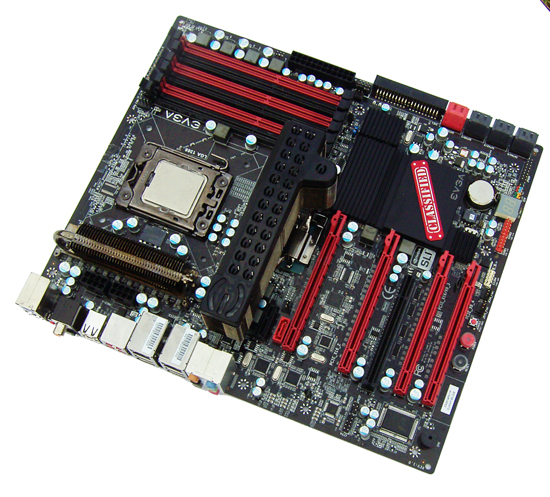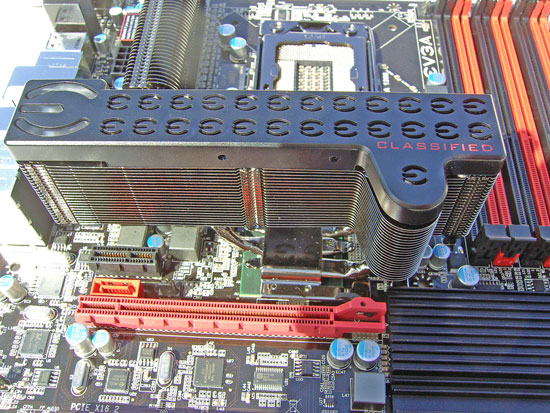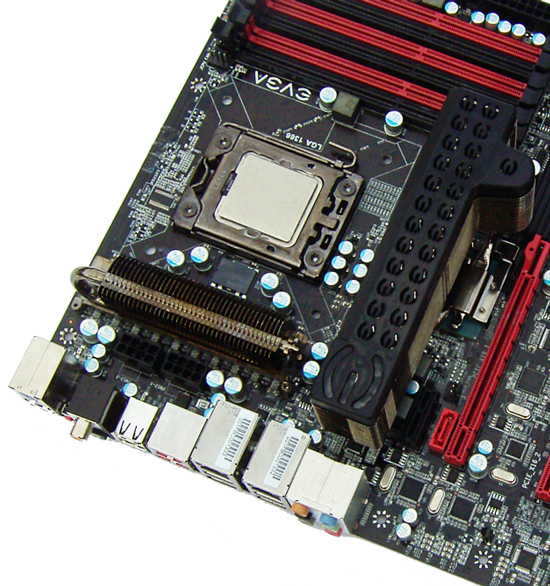EVGA X58 Classified - Trophy Board
by Rajinder Gill on May 8, 2009 3:30 AM EST- Posted in
- Motherboards
The Board
 |
The final rendition of the heatsink is a little smaller than what was on our ES sample. The reduction in size makes the heatsink compatible with the bulkier CPU coolers and allows the use of a "long" soundcard in the top PCI-E slot. Feature wise, everything we mentioned in our ES preview made it to retail release.
The ES board did leave us hopeful of a release with minimal end-user issues. On the BIOS front at time of publication, the one remaining requested fix is proper CPU FAN Speed recovery from S3 Sleep states. EVGA is addressing this and a fix should be ready shortly.
A certain amount of "pickiness" has also been revealed with certain batches of PSUs. We've encountered no problems ourselves using the venerable PCP 1200W and Corsair HX1000w PSUs. Based on these problems and ones that we have experienced with other X58 boards, we suspect the problems are with start-up current protection timing on older units. We recommend you head over to the EVGA forums to see if your PSU is on the potential hazard list before you purchase the components for your build. Units from Enermax and Thermaltake seem to be those with the most compatibility issues thus far, although not all batches seem affected, suggesting that revisions are already in the wild.
The retail board exhibited excellent compatibility with our own test hardware. Everything from onboard sound to various USB devices and peripheral cards including RAID controllers works. We can find nothing negative when it comes to overall functionality of the board.

Despite its size, the IOH cooler employed by EVGA on the Classified is not suitable for passive cooling of the IOH/ICH and NF200 when used in a closed PC case during overclocking runs. We have found temperatures can easily soar over 80C if there is no cross-flow across the heatsink. EVGA's design allows the user to mount a small 40mm fan to the PCI-E slot side of the heatsink that should help reduce temperatures into the 50C region and ensure stability when overclocking.
Unfortunately, you will have to buy a fan separately, which we think should have been included in the retail package considering the price of the motherboard. A well-executed waterblock option with a heatpipe linking all critical areas would also have been welcome on a board in this price range. Active cooling of this heatsink is necessary in any overclocking configuration; expect overclocking and even stock stability in poorly ventilated cases to be somewhat flaky without some form of cross-flow.
CPU side mounting holes are not provided, because the space between the heatsink and most of the larger CPU coolers is not sufficient to place a dedicated fan into this area. It is possible to mount coolers like Thermalright Ultra 120 or Noctua NHU12P in either direction. There's just enough room to allow for push-pull fan configurations too, leaving a paper width of space between either the memory modules and the fan or the IOH heatsink and the fan in both orientations.

The PWM heatsink is segregated from the IOH heatsink and cools both the PWM FET's and inductors. The low voltage situations experienced in daily use do not require active cooling in this area. However, you'll find that cross-flow is again needed to keep temps in the 40-50C region when overclocking as the heat dump from the FET's and Inductors into the sink becomes quite substantial as soon as you elevate VID above 1.4V or so. It's not always easy getting airflow into this area of a board either. Again, a 40mm fan will suffice for the most part, but you'll probably have to find some way of balancing it around the heatsink or using a case like the CM Stacker 830 with fans in the side door that blow air across the board.










40 Comments
View All Comments
Bolas - Tuesday, September 8, 2009 - link
When do we get a version of the classified board that supports USB 3.0?vanilla guerilla - Sunday, November 1, 2009 - link
why? are all your usb 3.0 devices upset that their present interfaces are too slow?MHz Tweaker - Thursday, June 25, 2009 - link
First off, it is good to see so much back and forth about a product. While I may not agree with some views, I value everyone's right to express them.My last few boards were as follows:
Asus P4P800 Deluxe
Epox Epox 9NDA3+
Asus A8N-SLI
DFI LT X48-T2R (horrible board and company)
eVGA Classified w/ NF200
I am not a fanboy of any company. If a company makes a product that fits my needs then I buy it. If my needs are not met, I look elsewhere.
I enjoy overclocking. I have large storage requirements. While not an avid gamer, I do play once in a while. I multitask with dozens of things going on at once. I am very impatient ;-)
I wanted a board that would allow me to load it down with internal and external drives, printers, video cards and overclock at the same time. For me the Classified is that board. This is the first board I have owned that has given me capability and stability in the same package.
I know there was a lot of hype leading up to the release of the Classified board. Based on eVGA's first x58 board and my experience with them as a company, I was one of the first to buy this board. I am not sure I agree with this review's title. To me a "Trophy Board" would be more about being costly and exclusive than function. While this board is costly AND expensive, it very much delivers the goods. Just my opinion. In the same breath, I also believe that there are boards out there that offer a better value for the money if you just want a solid board. As others have said, this board is not for everyone. It does shine when every port, slot and socket is filled and pushed to the bleeding edge.
I run the 920 C0 @4GHz w/6gig Dominators. I have 10internal HD's, 4 external HD's,2 DVD and 1 blueray burner(s) . I have dual 4850's and a 4870x2 driving 3 28" LCD's. I have 3 printers connected.
I think back over the last 10-15 years how much component prices have come down and how capability has soared. I can remember spending four times the price of this Classified board for 1.7gig SCSI hard drives. I can remember spending double the price of the i7 920 chip for a P166 chip back in the day. I can remember running Windows 3.11 for workgroups on that same P166 chip with an external Philips CDD-521 CD burner that cost $5000. I can remember saying a prayer every time I burned a $40 blank CD that the coaster goblins would not claim it.
Compared to other boards, the Classified is more expensive yes. For me this extra money was well spent in that I now have a board that meets my above requirements. I also have a board that should something go wrong it I can make a phone call and another board will be sent to me overnight via the advanced RMA program. I think about all the times I have spent less(and MORE) money on things only to be plagued with technical problems or trying to deal with a horrible company (DFI). When I have dealt with eVGA, I have been given quick straightforward solutions. For this alone I would pay extra.
It is good see eVGA release derivatives of the classified board at different price points.
At the risk of being labeled "fanboy", I am happy with this board and eVGA as a company. The thing about setting the bar high is eventually another hungry company will rise to the challenge. Excellence is not a resting place, keep striving and do the best you can with what you have.
Sabresiberian - Wednesday, May 27, 2009 - link
Wow. Just found out about the dual-processor Mac Pro. don't know much about it, but Apple has actualy produced a product interesting to me, which it hasn't done since the Lisa.So, any chance of a dual-CPU Classified?
:D
Necrosaro420 - Friday, May 15, 2009 - link
Im sure this will be like a typical evga motherboard. Itll be flawed for about 9 months until they finally come out with a bios to make it work correct.CMDRSweeper - Sunday, May 17, 2009 - link
Actually it won't...Why? Because this time it isn't one of the crappy Nvidia chipset's like the ones you think of.
That wasn't EVGA's fault but Nvidia's blind Intel trust and overall stupidity and of course lack of knowledge in chipset design.
This one has only an NF200 chip, an annoying rascal in itself but harmless if kept cool.
The chipset however is from Intel, and we all know how rock solid those are.
FXi - Tuesday, May 12, 2009 - link
1 Firewire 800? Need it, buy a card. Don't care for the price, don't buy this product, it's not for you.2 Complaints about price or reviewing high end products? Anand has reviewed many cheaper products from many vendors, Asus, MSI, etc. This is a review on a Ferrari! If you don't want it that's ok. I don't need one either. But appreciate that it's a unique and low volume product meant for a few specific kinds of customers. And then just appreciate that it can do 200mph, even if YOU will never do that speed :)
3 People complain about the price, but there are plenty of EVGA products priced lower. ENTHUSIASTS have been crying for this kind of board, high, high, super high end with some very unique features. This board does serve that purpose very well. If it doesn't meet your feature set, you need a different board. And there are tons out there :)
Only complain is that maybe a slightly more expensive $5 Intel network chip might have been nice as well as some more effective cooling. But they did a bang up job and gave a very good showing on the cooling, so not much of a negative really. EVGA did very well. Even the NF200 doesn't really harm much. NB temps would also have been helpful.
Overall it's the Super Man of motherboards, and you took it to places it was meant to go. Congrats AT.
takumsawsherman - Tuesday, May 12, 2009 - link
Dual Gigabit ethernet? Need it, buy a card.See how easily that fits? After all, most people who are overclocking this board will never use the bandwidth available in a gigabit ethernet solution over the fast ethernet.
I agree that some people are single minded, and will give up a lot to be able to freeze a computer and overclock it. So I think the board should use fast ethernet only (one port), keep the firewire400-only solution it currently uses, and get rid of the SP/DIF port. Very few people need that. And a PS/2 keyboard? What high roller uses PS/2 anyway? Speaking of, it is almost equally hilarious that they acknowledge that PS/2 keyboards are sometimes necessary, since USB keyboards can be fussy with the whole "Press Delete to enter BIOS" bit, especially until they are "accepted" by Windows. But then they leave out the Mouse port, which means that until you log into Windows without issue (yum, tab keys) your mouse may be quite useless.
I tell you, when they focus on overclocking, any compromises are acceptable. Just buy a card! Heck, use one of the PCIe x16 slots, since you aren't gonna put 4 video cards in this thing anyway.
TA152H - Tuesday, May 12, 2009 - link
Actually, there's no reason to use a USB keyboard. PS/2 keyboards have less overhead, so are a better choice. Why have an overclocker that uses extra cycles on the keyboard because it's using the Universally Slow Bus? USB was invented by Intel to slow down your computer, so you'd need a Pentium processor. It's bad at everything it does, whether it be handling a mouse, or a keyboard, or a hard disk interface. There's always a better option, except when it doesn't matter. For a high performance motherboard, performance matters. Every little bit.I will not buy a motherboard that doesn't have PS/2 ports. USB based mice and keyboards do nothing they don't, and slow the system down. It's, admittedly, very, very slight on today's processors, but still, why pay any penalty for nothing gain?
Necrosaro420 - Friday, May 15, 2009 - link
Sure, why not just leave the pci-e off and use agp or pci. Hell, put an isa video card slot on there while your at it.USB keyboard/mouse isnt going to slow your system down unless your running a p1 or original celeron.